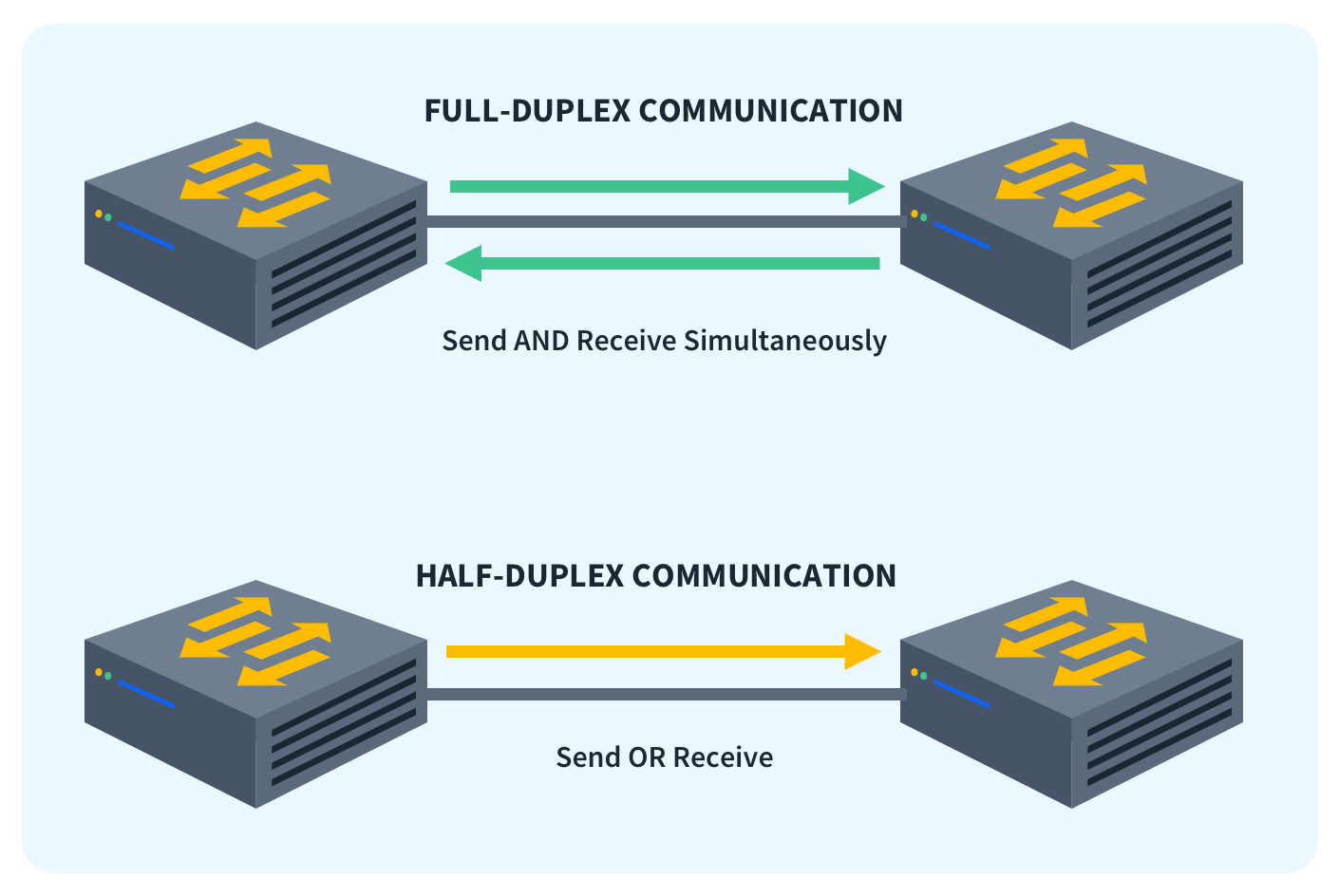Half-Duplex vs Full-Duplex: What are the Differences?

Quick Definition: Full-duplex enables simultaneous two-way communication, which allows data to flow freely bidirectionally. Half-duplex enables two-way communication, but not simultaneously. Half-duplex requires switching between a sending and receiving mode.
Half-duplex and full-duplex are two common methods of transmitting data. Half-duplex is when data can only go in one direction at a time. Full-duplex is when data can flow in both directions at the same time. Understanding the difference between these two is critical for troubleshooting and choosing devices for your network.
Also, a thorough understanding is required if you plan to take the Network+ Exam or the CCNA. Let’s start by going into detail on the half-duplex, including its advantages, and then do the same for full-duplex.
What is Half-Duplex?
Half-duplex is a mode of communication where data can only move in one direction at a time. A walkie-talkie is a perfect example. When speaking into a walkie-talkie, you must hold a button down, allowing you to communicate. When the button is released, incoming communication can be heard.
In the early days of the internet, Ethernet hubs commonly operated in half-duplex mode, allowing only one device on the network to transmit data at a time. However, modern Ethernet switches predominantly operate in full-duplex mode, enabling simultaneous two-way communication between connected devices and significantly improving network performance.
What are the Advantages of Half-Duplex?
Most of half-duplex’s advantages stem from its simplicity and ease of use. Let's look at specific reasons why you might choose half-duplex.
Half-Duplex is Low-Cost
Half-duplex is not a complicated technology, so it can be implemented cheaply. For instance, walkie-talkie and certain intercom systems can be inexpensive due to their half-duplex nature.
Half-Duplex is Great for Outdoor Usage
Due to their rudimentary nature, half-duplex equipment is often used in more rugged environments. After all, the less technology there is, the less technology there is to break. While plenty of circumstances warrant half-duplex technology, not every situation needs it.
Half-Duplex is Easy to Set Up
The gear is easy to set up and troubleshoot in situations where half-duplex will suffice. Often, half-duplex equipment simply needs to be turned on to work. For example, walkie-talkies and legacy Ethernet hubs take no prior configuration.
What are the Disadvantages of Half-Duplex?
Half-duplex certainly has its use cases, but they are limited in a modern business environment. Here are some of the reasons:
Half-Duplex has a Low Throughput
Half-duplex has limited throughput since data can only be sent one way at a time. This dramatically impedes a network's speed and reliability.
Half-duplex is Often Incompatible
Half-duplex equipment is largely incompatible with modern networks due to full-duplex requirements. Modern networks require the robustness and speed of full-duplex communication.
Half-Duplex has High Latency
Since devices must take turns sending and receiving data, half-duplex communication has inherent latency. This delay might be insignificant in some applications but can be problematic in real-time, high-demand systems.
What is Full-Duplex?
Full-duplex is a communication method that simultaneously transmits data to and from the recipient. A telephone is a prime example. During a conversation, both parties can speak and respond without waiting for the other to finish speaking before replying.
In addition to telecommunication, full-duplex is used in Ethernet, fiber optics, cable modems, switches, and more. Full-duplex fiber optics form the backbone of the internet, crisscrossing under the sea to create its core infrastructure.
The general rule of thumb is: unless the network is very old, if it is used to transmit data on an Ethernet LAN, it’s probably full-duplex.
What are the Advantages of Full-duplex?
Full-duplex mode comes with a host of advantages that prove vital to the speed and reliability of your network. Benefits such as:
Full-Duplex has Enhanced Data Speeds
Full-duplex communication allows for faster data transfer as devices can both send and receive information simultaneously. This increases data transfer speeds compared to half-duplex or simplex communication. (Simplex communication is unidirectional data transmission, like a keyboard.)
Full-Duplex has Greater Throughput
The ability to send and receive data at the same time greatly increases the rate of transmission. This is especially beneficial when high data rates are required, such as video streaming and VoIP. So not only is data sent faster, but more can be sent at the same time.
Full-Duplex is Ideal for Complex Networks
Full-duplex is better suited for modern, complex, and demanding network environments, where high-speed data transmission and efficiency are essential.
What are Disadvantages of Full-duplex?
Although full-duplex offers numerous benefits, it's essential to be aware of certain drawbacks associated with this mode of communication. Let’s run through a couple of them.
Full-Duplex has High Power Consumption
Full-duplex machines often require far more power than their half-duplex counterparts. This can rack up utility bills and generate heat that requires cooling down.
Full-Duplex is Costly
Implementing full-duplex systems might be more complex and expensive compared to half-duplex systems. Additional hardware, better cabling, and more sophisticated devices will be required to get everything up and running. This increases the overall cost of setup and maintenance.
Full-Duplex is Susceptibility to Errors
Full-duplex communication is more susceptible to errors and data collisions when improperly managed. Collisions in simultaneous data transmission can lead to data loss or retransmissions, reducing efficiency. Luckily, many modern routers and switches have ways of significantly mitigating data collisions.
Final Thoughts On Full-duplex and Half-duplex
Understanding the difference between full-duplex and half-duplex is important when studying for the Network+ and CCNA. It is also required knowledge for any network engineer.
In summary, full-duplex allows for simultaneous transmission in both directions. Half-duplex, on the other hand, can only go in one direction at a time.
For more information on networks, we recommend the following articles:
Not a CBT Nuggets subscriber? Sign up for a 7-day free trial.
delivered to your inbox.
By submitting this form you agree to receive marketing emails from CBT Nuggets and that you have read, understood and are able to consent to our privacy policy.
